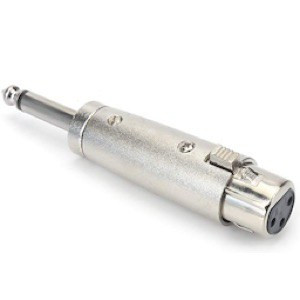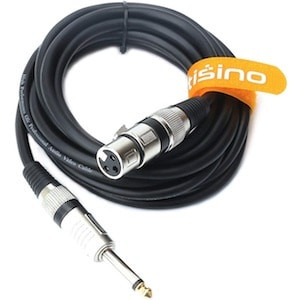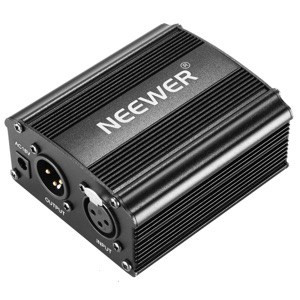Connecting a microphone to a guitar amplifier might seem unconventional, but it opens up exciting possibilities for vocal effects and unique sound textures. At guitarplayers.net, we’ll explore the process of adapting your microphone to work seamlessly with your guitar amp, allowing you to experiment with vocal distortion, looping, and other creative effects. This guide will provide you with the knowledge to achieve the best sound, covering everything from cable adapters to power considerations, and even how to minimize feedback. Let’s dive into the world of microphone and guitar amplifier integration, unlocking new sonic landscapes for your music with great sound quality, dynamic range, and tone shaping options.
1. Understanding the Basics: Adapting XLR to 1/4″ TS
Microphones commonly use balanced XLR outputs, while guitar amplifiers typically utilize unbalanced 1/4″ Tip-Sleeve (TS) inputs. Therefore, to effectively connect a microphone to a guitar amplifier, an adapter is essential.
1.1. Choosing the Right Adapter Cable
An adapter cable with a female XLR (XLRF) connector on one end and a 1/4″ TS connector on the other is necessary. There are two primary types:
-
XLRF to TS Cable: This cable features an XLRF connector on one end and a 1/4″ TS plug on the opposite end, available in various lengths.
- Example: Tisino XLRF to 1/4″ TS Adapter
 Tisino XLRF to 1/4" TS Adapter
Tisino XLRF to 1/4" TS Adapter -
XLRF to TS Cable (Longer Length): Similar to the adapter above but with a longer cable length.
- Example: Tisino XLRF to 1/4″ TS 25′ cable
 Tisino XLRF to 1/4" TS Adapter 25' Cable
Tisino XLRF to 1/4" TS Adapter 25' Cable
These adapters facilitate a straightforward connection between a microphone and a guitar or bass amplifier.
1.2. Can I Use a TRS Connector Instead of TS?
While guitar amps are designed for Tip-Sleeve (TS) connections, using a Tip-Ring-Sleeve (TRS) connector can also work. Microphones output mono balanced audio, and as long as the Tip and Sleeve connections are properly aligned, the Ring connection on the TRS plug will be effectively ignored within the amplifier’s TS jack.
2. Powering Active Microphones: Supplying Necessary Voltage
Connecting a microphone to a guitar amp is only the first step. Ensuring a signal transfer from the microphone to the amplifier requires additional consideration.
2.1. Passive vs. Active Microphones
- Passive Microphones: Dynamic microphones (moving-coil and ribbon) do not need external power.
- Active Microphones: Condenser microphones and some ribbon mics need external power, such as DC bias voltage or phantom power. Guitar amplifiers don’t supply this, so you need an alternative.
2.2. External Power Solutions
Tube microphones often have dedicated external power sources that work well with guitar amps. However, phantom-powered or DC-biased microphones require different solutions:
-
Phantom Power: Use an external phantom power supply.
- Example: Neewer 1-Channel Phantom Power Supply
 Neewer 1-Channel Phantom Power Supply
Neewer 1-Channel Phantom Power Supply -
DC-Biased Microphones: These are often lavalier mics that receive power from wireless transmitters. Connect the wireless receiver’s output to the guitar amplifier.
2.3. Further Reading on Microphone Power
For a more in-depth understanding of powering microphones, explore the article, “Do Microphones Need Power To Function Properly?” on guitarplayers.net.
3. Understanding Microphone Signals in Guitar and Bass Amps
Guitar and bass amps are designed for instrument signals, so it’s important to understand the differences between microphone signals and instrument signals.
3.1. Limited Frequency Response
Guitar and bass amplifiers don’t reproduce the full audible spectrum (20 Hz – 20,000 Hz). They usually top out around 6 kHz. While bass cabinets can produce lower frequencies (below 40 Hz), guitar amps typically have a higher low-end cutoff. Microphones have a wider frequency response. This means the guitar/bass amplifier won’t reproduce the mic signal accurately.
3.2 Balanced Mic Output and Unbalanced Amp Input
XLR microphones output balanced audio, while guitar/bass amplifiers have unbalanced (TS) inputs. The adapters mentioned above will take care of changing the audio from balanced to unbalanced. It’s generally fine to plug a balanced TRS plug into an unbalanced TS jack, so it’s not a big deal if the adapter is an XLRF to 1/4″ TRS. That being said, I would not advise adapting the mic signal to an unbalanced cable that connects it to the amplifier. Long unbalanced cables are susceptible to electromagnetic interference and may cause unnecessary signal degradation.
3.3. Gain Considerations
Microphone signals are generally weaker than instrument-level signals. This means the amp needs more gain to reach the same volume.
4. Can I Connect a Microphone To Guitar Effects Pedals?
Yes, you can connect a microphone to guitar effects pedals! Many guitarists and vocalists experiment with running vocals through effects pedals for creative sound design.
4.1. How to Connect
Guitar and bass pedals typically have 1/4″ Tip-Sleeve jacks, just like guitar/bass amplifiers. To plug a regular XLR microphone into a guitar pedal, follow the instructions above for connecting a mic to an amp. All that is needed is an XLRF – 1/4″ TS adapter!
4.2. Creative Effects
Experiment with different effects to find unique sounds. Distortion, reverb, delay, and modulation effects can drastically alter your vocal tone.
5. Minimizing Feedback: Tips and Techniques
Feedback is a common issue when using microphones with amplifiers, so it’s important to take steps to prevent it.
5.1. What Causes Feedback?
Feedback occurs when the sound from the amplifier is picked up by the microphone and re-amplified, creating a loop.
5.2. Preventing Feedback
- Gain Control: Keep the amp gain below the feedback threshold.
- Mic Placement: Distance the mic from the cabinet and point it away from the speaker.
- Room Acoustics: Improve room acoustics to reduce reflections.
5.3. Further Reading on Feedback
To delve deeper into feedback prevention, check out “12 Methods To Prevent & Eliminate Microphone/Audio Feedback” on guitarplayers.net.
6. Why Connect a Microphone to a Guitar Amplifier?
There are several reasons why you might want to connect a microphone to a guitar amplifier.
6.1. Recording Purposes
Putting a microphone in front of a guitar or bass amplifier will record a strong, isolated audio signal from the amp.
6.2. Live Performance
In live situations, placing a mic in front of an amp will help reinforce the sound of the amp by allowing its sound to be projected by the PA system and not just the amp speaker. This ensures that the amplifier’s sound is adequately amplified and projected through the PA system, reaching a wider audience without relying solely on the amp’s speaker.
7. Choosing the Right Microphones for Miking Amps
Selecting the right microphone can significantly impact the quality of your sound when miking amplifiers. Different microphones excel in capturing specific tonal characteristics, making them suitable for various applications and preferences. Whether you’re recording in a studio or performing live, using the appropriate microphone can enhance the clarity, depth, and overall impact of your amplified sound.
7.1. Microphones for Bass Guitar Cabinets
Choosing the best microphone for bass guitar cabinets is essential for capturing the deep, resonant tones of your bass. Dynamic microphones like the Shure Beta 52A or AKG D112 are popular choices due to their ability to handle high sound pressure levels and accurately reproduce low frequencies. These microphones provide a robust and clear representation of the bass guitar’s sound, making them ideal for both recording and live performances.
7.2. Microphones for Electric Guitar Cabinets (Live)
For live performances with electric guitar cabinets, selecting a microphone that can handle the loud volumes and dynamic range is crucial. Dynamic microphones such as the Shure SM57 and Sennheiser e609 are widely used for their durability and ability to capture the aggressive tones of electric guitars on stage. These microphones are designed to withstand the rigors of live environments while delivering consistent and reliable sound quality, ensuring that your guitar’s sound cuts through the mix.
7.3. Microphones for Electric Guitar Cabinets (Studio)
When recording electric guitar cabinets in the studio, you have the flexibility to choose microphones that offer exceptional detail and nuanced sound capture. Condenser microphones like the Neumann U87 or Royer R-121 ribbon microphone are often favored for their ability to reproduce the subtle characteristics and harmonic richness of electric guitars. These microphones provide a high level of sonic fidelity, allowing you to capture the true essence of your guitar’s tone with exceptional clarity and depth.
8. Where Can I Plug In a Microphone?
Microphones typically plug into mic inputs with mic preamplifiers. These inputs/preamps provide the necessary gain to bring the mic level signal to line level for use with other audio equipment.
8.1. Exploring Microphone Connections
For a detailed account of microphone connections and connectors, check out the article, “What Do Microphones Plug Into? (Full List Of Mic Connections)” on guitarplayers.net.
9. Comprehensive Microphone Buyer’s Guide
Choosing the right microphone(s) for your applications and budget can be a challenging task. For this reason, guitarplayers.net has created a Comprehensive Microphone Buyer’s Guide. Check it out for help in determining your next microphone purchase.
10. Frequently Asked Questions (FAQ)
10.1. What Adapter Do I Need to Connect a Microphone to a Guitar Amp?
You need an XLRF to 1/4″ TS adapter cable.
10.2. Can I Use a Regular Microphone Cable?
No, you need an adapter to convert the XLR connection to a 1/4″ TS connection.
10.3. Why Does My Microphone Need Power?
Active microphones, like condenser mics, need power to operate. Passive microphones, like dynamic mics, do not.
10.4. Will I Damage My Guitar Amp by Plugging in a Microphone?
No, you won’t damage your amp as long as you use the correct adapter and power supply (if needed).
10.5. How Do I Prevent Feedback?
Control the gain, distance the mic from the amp, and optimize your room acoustics.
10.6. Can I Use This Setup for Recording?
Yes, but be aware of the limited frequency response of guitar amps.
10.7. Can I Use This Setup for Live Performances?
Yes, it can be a creative way to process vocals in live settings.
10.8. Will My Vocals Sound Good Through a Guitar Amp?
That depends on the effect you’re trying to achieve. Guitar amps color the sound, so it’s not a neutral setup.
10.9. Do I Need a Special Microphone?
No, you can use any standard microphone, but dynamic mics are often preferred for their durability.
10.10. Where Can I Learn More About Microphones and Guitar Amps?
Visit guitarplayers.net for more articles, lessons, and community discussions.
Connecting a microphone to a guitar amplifier can open up new creative possibilities for your music. By understanding the necessary adapters, power requirements, and potential issues, you can safely and effectively experiment with this unique setup. Visit guitarplayers.net to discover more tips, tricks, and resources for guitarists of all levels. Whether you’re looking for lessons, reviews, or a community to connect with, guitarplayers.net has something for everyone. Join our community today and take your guitar playing to the next level!
Address: 1140 Boylston Street, Boston, MA 02215, United States
Phone: +1 (617) 747-2261
Website: guitarplayers.net